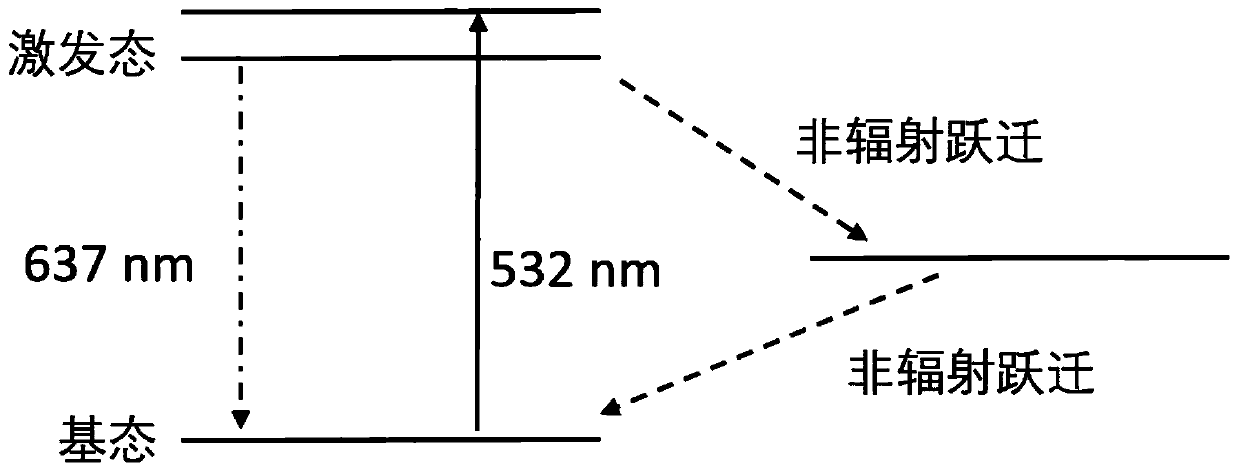A method and device for generating random numbers based on diamonds
A random number and diamond technology, applied in the field of random number generation based on diamond, can solve problems such as complex optical path coordination, and achieve the effect of stable light source
- Summary
- Abstract
- Description
- Claims
- Application Information
AI Technical Summary
Problems solved by technology
Method used
Image
Examples
Embodiment 1
[0041] Example 1: Use a block diamond sample to extract a random number signal according to the first method:
[0042] according to figure 2 As shown, the quantum random number generator based on diamond photoluminescence defects proposed by the present invention mainly includes: a 532nm laser, a diamond block sample containing a nitrogen-vacancy center and a photon detector.
[0043] Compared with nano-diamond samples, the density of the nitrogen-vacancy center structure of bulk samples can be made larger. Under laser irradiation, a large number of nitrogen-vacancy centers are excited to produce fluorescence, because the luminescence of each nitrogen-vacancy There are some subtle differences in the characteristics, and because of their spatial positions, although two different nitrogen-vacancy centers may emit light at the same time, but due to their spatial positions, the detection time of the detector will also be different. has a difference
[0044] The light emitted fr...
Embodiment 2
[0047] Embodiment 2: Use the nano-diamond sample to extract the random number signal according to the first method:
[0048] according to figure 2 As shown, the quantum random number generator based on diamond photoluminescence defects proposed by the present invention mainly includes: a 532nm laser, a nano-diamond sample containing a nitrogen-vacancy center and a photon detector.
[0049] Compared with bulk diamonds, nanodiamonds are cheaper in price and lower in cost.
[0050] The solution of nano-diamond powder was spin-coated on a glass slide and dried. The light emitted from the laser is irradiated on the nanodiamond containing the nitrogen-vacancy center in the sample, so that the nitrogen-vacancy center in the nanodiamond generates photons of 600 to 800 nm, and the photon of this band is detected by the photon detector and each photon The time-of-arrival signal is stored and passed to the signal processing module.
[0051] In the signal processing module, the averag...
Embodiment 3
[0052] Embodiment 3: extract random number signal according to the second method
[0053] according to image 3 As shown, the quantum random number generator based on diamond nitrogen-vacancy centers proposed by the present invention mainly includes: a 532nm laser, a diamond block sample containing nitrogen-vacancy centers, a beam splitter, and a photon detector.
[0054] The light emitted from the laser is irradiated to the part containing photoluminescent defects in the sample, so that the nitrogen-vacancy center in the diamond generates photons with a wavelength of 600-800nm, and the photons with this wavelength pass through the beam splitter, and there will be a 50% probability along the One path and 50% probability follow the other path, and the photon arrival information is recorded by the photon detector, and the event arriving at one detector at a certain time is defined as 1, and the event arriving at the other detector is defined as 0. Pass this information to the s...
PUM
| Property | Measurement | Unit |
|---|---|---|
| Wavelength | aaaaa | aaaaa |
Abstract
Description
Claims
Application Information
 Login to View More
Login to View More - R&D
- Intellectual Property
- Life Sciences
- Materials
- Tech Scout
- Unparalleled Data Quality
- Higher Quality Content
- 60% Fewer Hallucinations
Browse by: Latest US Patents, China's latest patents, Technical Efficacy Thesaurus, Application Domain, Technology Topic, Popular Technical Reports.
© 2025 PatSnap. All rights reserved.Legal|Privacy policy|Modern Slavery Act Transparency Statement|Sitemap|About US| Contact US: help@patsnap.com



